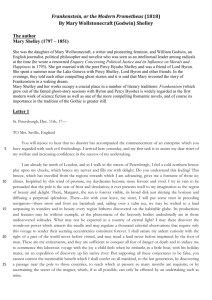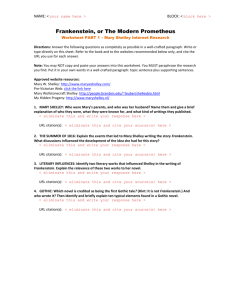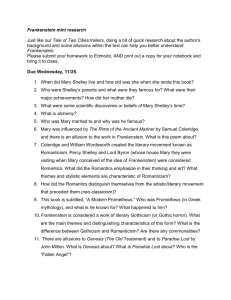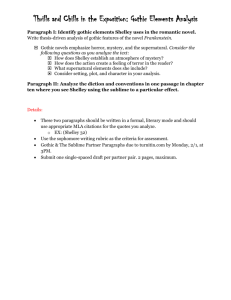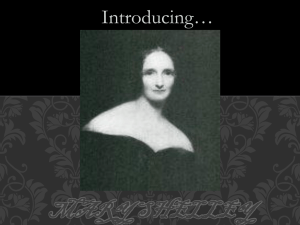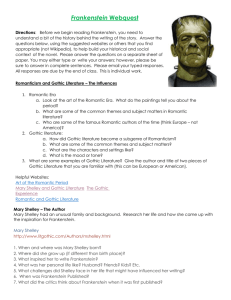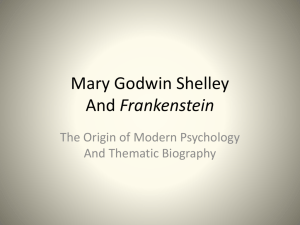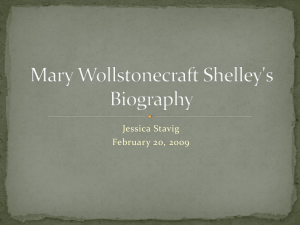Senior notes on Frankenstein
advertisement
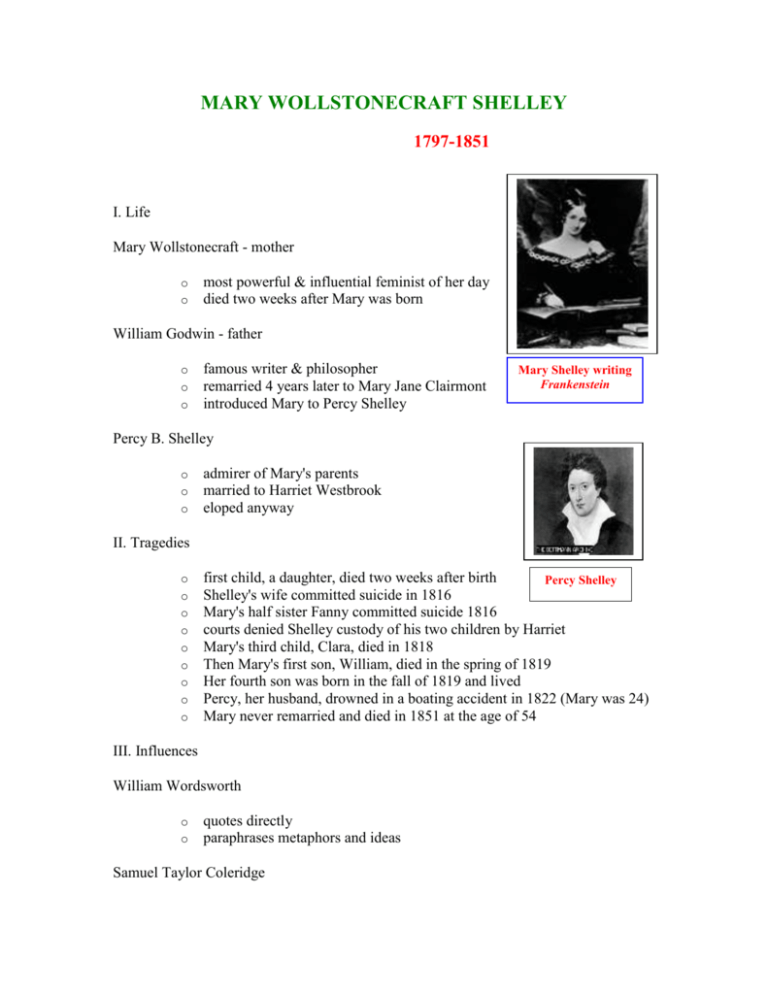
MARY WOLLSTONECRAFT SHELLEY 1797-1851 I. Life Mary Wollstonecraft - mother o o most powerful & influential feminist of her day died two weeks after Mary was born William Godwin - father o o o famous writer & philosopher remarried 4 years later to Mary Jane Clairmont introduced Mary to Percy Shelley Mary Shelley writing Frankenstein Percy B. Shelley o o o admirer of Mary's parents married to Harriet Westbrook eloped anyway II. Tragedies o o o o o o o o o first child, a daughter, died two weeks after birth Percy Shelley Shelley's wife committed suicide in 1816 Mary's half sister Fanny committed suicide 1816 courts denied Shelley custody of his two children by Harriet Mary's third child, Clara, died in 1818 Then Mary's first son, William, died in the spring of 1819 Her fourth son was born in the fall of 1819 and lived Percy, her husband, drowned in a boating accident in 1822 (Mary was 24) Mary never remarried and died in 1851 at the age of 54 III. Influences William Wordsworth o o quotes directly paraphrases metaphors and ideas Samuel Taylor Coleridge o Rime of the Ancient Mariner is one of the central metaphors of the novel William Godwin & Mary Wollstonecraft (parents) Percy B. Shelley (husband) Lord Byron (friend) o suggested horror story contest Frankenstein Mary Shelley’s drawing of her creature I. Gothic Horror Story Genre A. Author emphasizes: o o o o o o grotesque elements the mysterious desolate environment the horrible the ghostly fear that can be aroused in the reader o sense of remoteness and uncertainty (setting in foreign/unknown country & time is contemporary because of modern science element) favors intuition and emotion intuitive: monster is born with emotions & feelings, but must learn how to read and write emotional: adoption of underprivileged children rejection of a marriage vow in favor of true love death of sweet William devotion of Victor & Elizabeth characters possess some sort of psychic communication (monster tends to appear out of nowhere in order to advance the plot) B. Characteristics o o o emphasize the strange, the bizarre, the unusual, and the unexpected (i.e. – living corpses, characters who refuse to die, frightening experiences) II. The Novel Sources o other gothic novels o William Godwin views concerning the innate goodness of man, the rational structure of ideal, and the idea of the hounded person o Coleridge’s “Rime of the Ancient Mariner” quoted and paraphrased throughout the novel suggests the device of the obsessive teller of a tale o Milton’s Paradise Lost female version “in which Victor & the monster…play neo-biblical parts” i.e. – the monster compares himself to Adam, but realizes that in actuality, he is the fallen angel o Legend of Prometheus idea of a violated contract between God and man Form o The Frame Device o tale is told to us by someone who reads or hears it from someone else o o o o o function is to give credibility to an otherwise implausible event or clear the narrator and/or author from responsibility for the events Theme of Corruption the monster begins innocent turns to murder after being rejected Victor Frankenstein creates the monster in a mood of mad pride abandons his creation Hollywood’s movie does not fulfill his duty society as a whole creature loss of innocence lack of responsibility lack of commitment no sense of duty Gothic Fiction The reader passes from the reasoned order of the everyday world into a dark region governed by: 1. Supernatural beings 2. Decay 3. Dread and horror Much of the inspiration for Gothic fiction was drawn from medieval buildings and ruins which featured castles and monasteries equipped with subterranean passages, hidden panels, chambers of torture, and dark towers. There are 2 styles of Gothic fiction: 1. Detective or mystery 2. Horror In Gothic fiction forces of evil predominate, usually in the person of a great villain. Opposed to these is a virtuous maiden who is at once repelled and attracted by the evil around her. In some novels virtue triumphs; in others the evil is so monumental that everything good in its path is destroyed, and then it destroys itself. Mary Shelley’s Frankenstein also has elements of science and horror fiction. Stephen King has also used Gothic settings very successfully in recent times.

